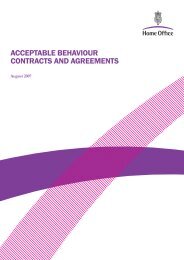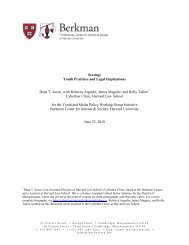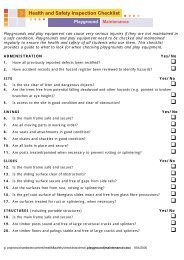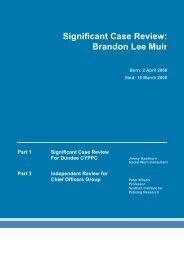Download PDF - Fair Play For Children
Download PDF - Fair Play For Children
Download PDF - Fair Play For Children
You also want an ePaper? Increase the reach of your titles
YUMPU automatically turns print PDFs into web optimized ePapers that Google loves.
the lanes, and entry signing to inform users they are entering the Quiet Lane network. They may<br />
help to improve access to play in rural areas.<br />
Safer cycle routes<br />
38.<br />
39.<br />
The increased funding for Cycling England mentioned above will include an infrastructure<br />
programme that will deliver an additional 250 safer links to school to approximately 500 schools<br />
via traffic calmed or traffic free routes, linked to the wider national cycle network, administered<br />
by the transport charity Sustrans. The routes, many of which will also serve other recreational<br />
venues, will help make the journey to school a far more positive experience for children and,<br />
with improved cycle training and cycle parking, should increase the number of children cycling<br />
to school. Many local authorities also have improved their local cycle networks again increasing<br />
the options for safer, more convenient cycle trips.<br />
The additional safe links build on the £18.4 million central government has previously invested<br />
in this programme through Sustrans. The investment has in turn generated £31m from local<br />
authorities and others. By 2008 we will have linked over 600 schools via the national cycle<br />
network to residential areas. On average, schools with links have doubled the number of pupils<br />
cycling to school, while walking to school has increased by 8 per cent.<br />
Improving accessibility – Travelling to School Project<br />
40.<br />
The Government wants as many children as possible to walk, cycle or use public transport to<br />
travel to school. In 2003 DfT and the then DfES therefore launched the joint Travelling to School<br />
project, which sets out how the Government wants all schools in England to develop a school<br />
travel plan in order to reduce car use for the journey to school and allow many more children to<br />
take regular exercise.<br />
41. The Travelling to School project is based around the delivery of school travel plans and it is DfT’s<br />
and DCSF’s stated objective that all schools in England (including independent schools) should<br />
have an approved school travel plan by March 2010. 56 per cent of schools already have such<br />
a plan.<br />
42.<br />
A school travel plan is a package of measures tailored to the needs of an individual school and<br />
designed to reduce car dependency and improve safety for journeys to school. Measures might<br />
include pedestrian and cycle training, walking buses and cycle trains, other walking/cycling<br />
incentive schemes, the provision of lockers and secure cycle parking and car sharing schemes.<br />
School travel plans are accepted as the key strategies for reducing car use for journeys to<br />
school.<br />
43. Travelling to School project is supported by £7.5m per annum joint DfT/DCSF funding to enable<br />
local authorities to employ a network of around 250 school travel advisers and regional school<br />
travel advisers to work with schools and help them develop and implement school travel plans.<br />
44.<br />
In addition DCSF is providing £20m a year for small capital grants for schools with approved<br />
school travel plans (£5,000 for a typical primary and £10,000 for a typical secondary school).<br />
<strong>Fair</strong> <strong>Play</strong>: A consultation on the play strategy<br />
69





![The Childcare Act 2006 - Notes [Website] - Fair Play For Children](https://img.yumpu.com/50144819/1/184x260/the-childcare-act-2006-notes-website-fair-play-for-children.jpg?quality=85)




![Bouncy Castles [PDF] - Fair Play For Children](https://img.yumpu.com/45463572/1/184x260/bouncy-castles-pdf-fair-play-for-children.jpg?quality=85)






